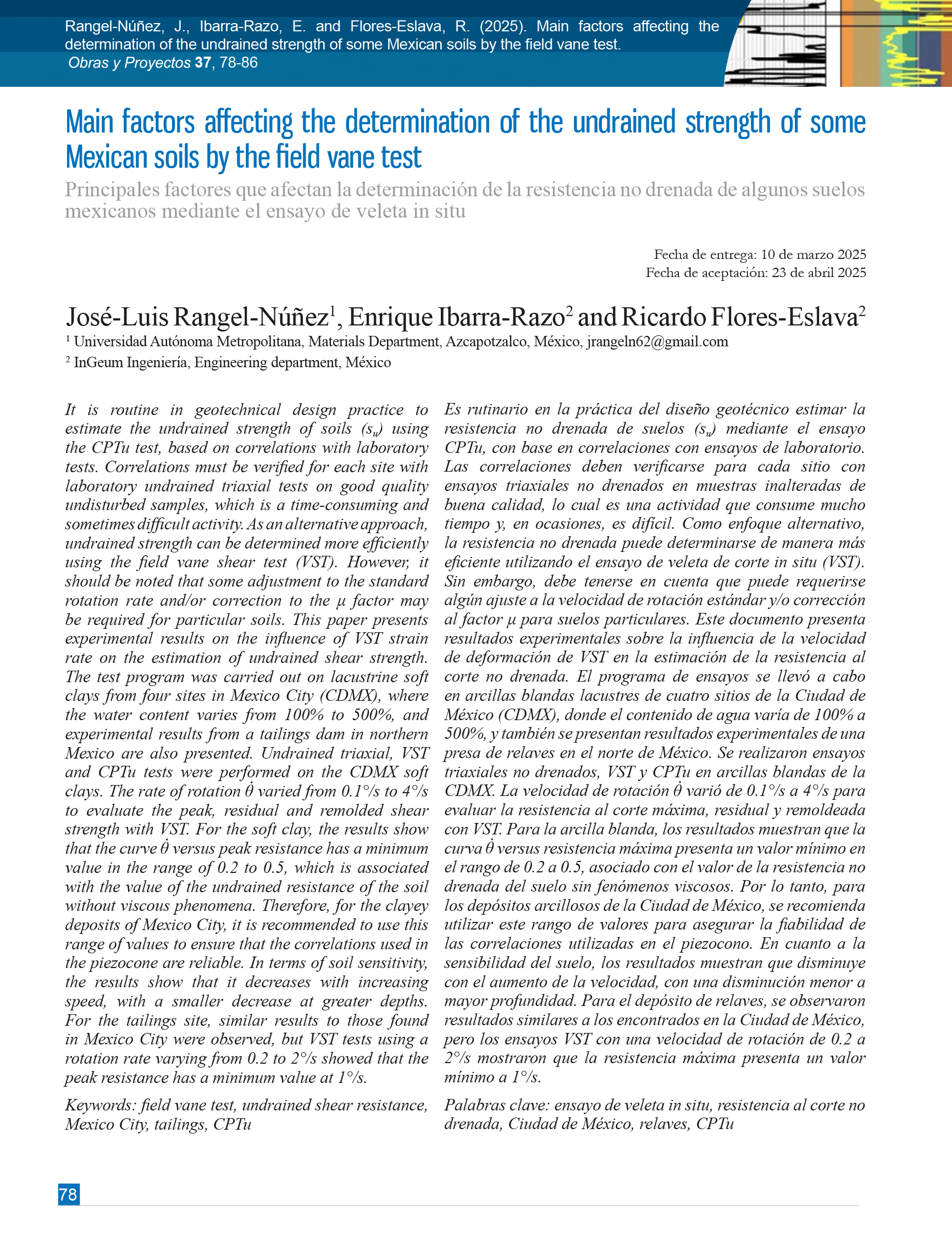Main factors affecting the determination of the undrained strength of some Mexican soils by the field vane test
DOI:
https://doi.org/10.21703/0718-2813.2025.37.3239Keywords:
Field vane test, Undrained shear resistance, Mexico City, Tailings, CPTuAbstract
It is routine in geotechnical design practice to estimate the undrained strength of soils (su) using the CPTu test, based on correlations with laboratory tests. Correlations must be verified for each site with laboratory undrained triaxial tests on good quality undisturbed samples, which is a time-consuming and sometimes difficult activity. As an alternative approach, undrained strength can be determined more efficiently using the field vane shear test (VST). However, it should be noted that some adjustment to the standard rotation rate and/or correction to the μ factor may be required for particular soils. This paper presents experimental results on the influence of VST strain rate on the estimation of undrained shear strength. The test program was carried out on lacustrine soft clays from four sites in Mexico City (CDMX), where the water content varies from 100% to 500%, and experimental results from a tailings dam in northern Mexico are also presented. Undrained triaxial, VST and CPTu tests were performed on the CDMX soft clays. The rate of rotation varied from 0.1°/s to 4°/s to evaluate the peak, residual and remolded shear strength with VST. For the soft clay, the results show that the curve versus peak resistance has a minimum value in the range of 0.2 to 0.5, which is associated with the value of the undrained resistance of the soil without viscous phenomena. Therefore, for the clayey deposits of Mexico City, it is recommended to use this range of values to ensure that the correlations used in the piezocone are reliable. In terms of soil sensitivity, the results show that it decreases with increasing speed, with a smaller decrease at greater depths. For the tailings site, similar results to those found in Mexico City were observed, but VST tests using a rotation rate varying from 0.2 to 2°/s showed that the peak resistance has a minimum value at 1°/s.
References
ASTM D2573 (2008). Standard test method for field vane shear test in cohesive soil. ASTM International, West Coshohocken PA, USA.
Bjerrum, L. (1973). Problems of soil mechanics and construction on soft clays and structurally unstable soils (collapsible, expansive and others). 8th International Conference on Soil Mechanics and Foundation Engineering, Moscow, USSR, vol. 3, 111-159.
Bjerrum, L. (1974). Problems of soil mechanics and construction on soft clay. Norwegian Geotechnical Institute, Publication 110, Oslo, Norway.
Eurocode 7 (2000). Geotechnical design. Part 3: Design assisted by field testing. Section 8: Field vane test FVT. European Committee for Standardization CEN, Brussels, Belgium.
Hirabayashi, H., Tanaka, M. and Tomita, R. (2017). Effect of rotation rate on field vane shear strength. 27th International Ocean and Polar Engineering Conference, San Francisco, California, USA.
Jamiolkowski, M., Ladd, C.C., Germaine, J.T. and Lancellotta, R. (1985). New developments in field and laboratory testing of soils. 11th International Conference on Soil Mechanics and Foundations Engineering. San Francisco CA, USA, Balkema, Rotterdam, Netherlands, vol. 1, 57-153.
Kayabali, K. and Tufenkci, O.O. (2010). Shear strength of remolded soils at consistency limits. Canadian Geotechnical Journal 47(3), 259-266.
Larsson, R. (1980). Undrained shear strength in stability calculation of embankments and foundations on soft clay. Canadian Geotechnical Journal 17(4), 591-602.
Peuchen, J. and Mayne, P.W. (2007). Rate effects in vane shear testing. 6th International Offshore Site Investigation and Geotechnics Conference: Confronting New Challenges and Sharing Knowledge, SUT, London, UK, 259-266.
Quinn, T.A.C. and Brown, M.J. (2011). Effect of strain rate on isotropically consolidated kaolin over a wide range of strain rates in the triaxial apparatus. International Symposium on Deformation Characteristics of Geomaterials, Seoul, South Korea.
Robertson, P.K. and Cabal, K. (2015). Guide to cone penetration testing for geotechnical engineering. 6th ed., Gregg Drilling & Testing, Inc., Signal Hill, USA.
Santoyo, E., Lin Xue, R. and Ovando, E. (1989). El cono en la exploración geotécnica. TGC Geotecnia, México.
Watson, P.G., Suemasa, N. and Randolph M.F. (2000). Evaluating undrained shear strength using the vane shear apparatus. 10th International Offshore and Polar Engineering Conference ISOPE. The International Society of Offshore and Polar Engineers, Seattle, USA, 485-493,
Wilson, L.J., Kouretzis, G.P., Pineda, J.A. and Kelly, R.B. (2016). On the determination of the undrained shear strength from vane shear testing in soft clays. Geotechnical and Geophysical Site Characterizations 5, Lehane, Acosta-Martínez and Kelly (eds.), Australian Geomechanics Society, Sydney, Australia, 455-460.

Downloads
Published
Issue
Section
License
Copyright (c) 2025 Universidad Católica de la Santísima Concepción

This work is licensed under a Creative Commons Attribution-NonCommercial 4.0 International License.







